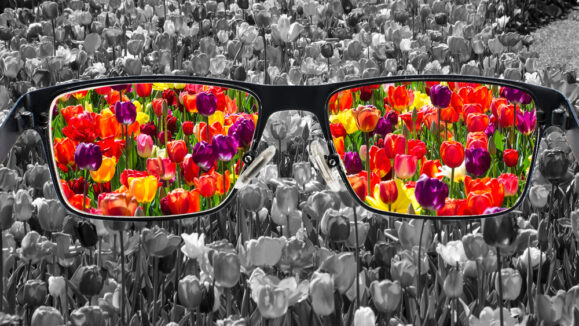Linguists and historians have no shortage of theories to explain why the Iliad and Odyssey likened the color of the Mediterranean to dark wine 3,000 years ago. Ancient Greek, as well as ancient Japanese and Hebrew, for a long time, lacked a word to distinguish “blue” separately from other colors. Having grown up with the modern color wheel, we may never quite understand why color perception then was different from ours today. However, we can be fairly sure, at least, that ancient humans were not suffering on a large scale from early macular degeneration — and that they weren’t all secretly octopuses.
Many people know that the octopus can mimic background colors to blend in with its environment, but what they don’t know is that it does so despite being colorblind! Instead, these cephalopods can discern what we can’t see so well: polarized light. By studying octopus and cuttlefish vision, Visual Ecology Expert Dr. Shelby Temple has brought us closer to understanding human macular pigment.
Having focused on aquatic animals for most of his career, four years ago Dr. Temple launched Azul Optics (Bristol, United Kingdom) after discovering that the technology he was using to test polarized vision in cuttlefish could be adapted to test polarized vision in humans. COOKIE’s writers were fascinated with the doctor’s career transition and eager to learn more, invited him to tell us what his discovery meant for eye health.
MP-eye: Origin Story
“I developed the core technology for this device by mistake. It was originally designed to measure octopus vision but I noticed, during the experiments, that I could see interesting patterns when looking at the polarized light fields.” Dr. Temple shared. Excitedly, he remarked that “it was serendipity.” The device deemed the “MP-eye,” is able to determine the state of a patient’s macular pigments by checking their sensitivity to polarized light.
Humans see polarization as a visual phenomenon called Haidinger’s brushes, a faint yellow bowtie or hourglass-shaped perception, caused by the shadow formed on our retina by macular pigments. Azul Optic’s MP-eye, measures a person’s ability to visualize these bowties, thereby measuring their macular pigment levels. With this information, eye care professionals can create a plan for preserving patients’ macular vision.
We can’t do much about the main cause of age-related macular degeneration (AMD), which is, of course, age. Nor can we do anything about genetic predisposition. Aside from that, we can — within reason — limit exposure to light from the blue end of the visible spectrum and maintain macular density.
Dr. Temple asserts that not enough attention is given to photochemical damage inflicted by blue light. While controlled, long-term studies on humans are all but impossible to carry out due to the length of time and imposed subject damage necessitated, there have been short-term epidemiological studies on animals demonstrating the causal relationship between blue light and AMD. He implores his audiences to explore the abundant research available on the topic, as well as recent official government reports to get a jumpstart on preventative eye care. As we know today, there was evidence that smoking caused cancer long before the fact was made mainstream in society.
Azul Optics also wants to help bring awareness to patients about how to take care of their eye health. It’s easy for people to ignore generic advice about health issues that won’t affect them until decades into the future. Providing an individual with a concrete number that assigns specific, personal risk to them may incline them to take precautions against risk factors: “We like numbers … so we’ve created a number system to tell people how at risk they are. It’s basically measuring their natural, internal sunglasses,” shared Dr. Temple.
Mitigating Eye Harm
“We can’t stop age-related macular degeneration; it’s a natural process of aging,” continued Dr. Temple. He advised that if precautions are taken throughout a person’s lifetime to mitigate blue light’s impact, AMD’s onset can be delayed to as late as 120-years-old. “Well, it doesn’t matter then,” Temple went on humorously, “you prevented it because it didn’t happen in your lifetime.”
Avoiding blue light completely is impossible without committing to a lifestyle underneath a rock at the bottom of the ocean. Almost everyone is guilty of being lazy about sun protection sometimes. Yet not everyone realizes that the biggest natural source of blue light is the sun. People often worry about UV light, not knowing that the next most energetic waves on the spectrum reach the back of the eye. If eye patients are made aware of the direct connection between sun exposure, blue light, and AMD, they’ll be more likely to remember their hat and sunglasses before leaving the house.
Moreover, even when we’re inside, and even when the sun is down, we have electronic device screens and LED bulbs glowing around the clock. Cityscapes incorporate more reflective surfaces (e.g., cars and skyscrapers) that beam light directly into our faces without shade. This increased blue light exposure, combined with rising average lifespans, means people nowadays are more likely to experience AMD at some point in their old age compared to the past.
With COVID-19 keeping us indoors, we’re meeting online with friends and coworkers, watching more TV, and using our screens constantly to shop or order food. Now more than ever, it is critical for people to be aware of their macular pigment health. The first adjustment recommended by Dr. Temple starts with screen exposure.
Patients need not immediately stress out about less screen time (a worthy goal, but a difficult one to sell to anyone). Rather, they can change the level of exposure by simply lowering their computer or phone brightness and adjusting color temperatures to be warmer. When they must use their electronic devices, blue light lenses (or even amber or yellow-tinted sunglasses) filter a percentage of the rays and work best in combination with other light reduction techniques.
Patients should also be aware of their diets. Most people don’t get enough lutein and zeaxanthin through fruits and vegetables. Eating dark green and bright colored fruits and veggies like kale, spinach, oranges, peppers, pumpkin and corn builds up natural macular pigment protection.
Antioxidants also stop cells from accumulating damage that could eventually lead to macular degeneration. Regularly incorporating dietary antioxidants through food or tea is therefore beneficial in the long haul for a patient. Smoking, in addition to its other detrimental effects on the eyes, limits the effectiveness of these helpful antioxidants.
“We want to inform people from as young as possible. That’s one of the things I love about our device. We can test people at the age of 5 and we can find out what their pigments are at a really young age. And the younger we find out, the more time people have to protect themselves. The more time they have to put in place these really simple measures,” said Dr. Temple.
After all, once retinal cells are dead, they’re gone for good. With this in mind, Dr. Temple doesn’t want to terrify patients into obsessing over blue light. He hopes the MP-eye device will be used to assess and track macular pigment density over time, much like numbers on a scale are used to measure weight. He urges that the best method is to take all the easy precautions and to be aware of macular degeneration before it becomes a threat to eyesight.




